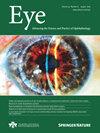犬类最佳疾病的翻译模型。
IF 2.8
3区 医学
Q1 OPHTHALMOLOGY
引用次数: 0
摘要
在这篇综述中,我们总结了几项犬BEST1疾病模型的临床前研究结果。为此,通过眼科检查、cSLO/sdOCT成像和视网膜免疫组织化学来评估客户拥有的和目的饲养的狗,分别是三种不同的BEST1突变中的两种或一种的复合杂合子或纯合子,以表征该疾病的临床和显微解剖特征。随后进行aav介导的基因治疗,在hVMD2启动子的控制下将BEST1转基因转移到RPE。我们证明了犬性视网膜病变是一种RPE-光感受器界面疾病,其RPE顶端微绒毛发育不全,分布在杆状和锥体外节。这导致微脱离,随后发展为临床明显的rpe -视网膜分离,以及一系列疾病阶段,从卵黄样病变到卵黄萎缩/萎缩性病变,类似于最佳卵黄样黄斑营养不良(BVMD)。基因治疗纠正微脱离和逆转大病变时,在疾病的假假说阶段交付。由于犬模型与BVMD具有相似的临床和显微结构异常,并且对基因治疗有积极的反应,因此犬模型是开发BVMD基因和其他治疗方法的有价值的转化模型。本文章由计算机程序翻译,如有差异,请以英文原文为准。

Canine Best disease as a translational model
In this review, we summarize the findings of several pre-clinical studies in the canine BEST1 disease model. To this end, client-owned and purpose bred dogs that were compound heterozygotes or homozygotes, respectively, for two or one of 3 different mutations in BEST1 were evaluated by ophthalmic examination, cSLO/sdOCT imaging, and retinal immunohistochemistry to characterize the clinical and microanatomic features of the disease. Subsequently AAV-mediated gene therapy was done to transfer the BEST1 transgene to the RPE under control of a hVMD2 promoter. We demonstrated that canine bestrophinopathies are an RPE-photoreceptor interface disease with underdeveloped RPE apical microvilli that invest rod and cone outer segments. This leads to microdetachments which later progress to clinically evident RPE-retinal separation and a spectrum of disease stages, ranging from vitelliform to vitelliruptive/atrophic lesions, similar to Best Vitelliform Macular Dystrophy (BVMD). Gene therapy corrects the microdetachments and reverses large lesions when delivered at the pseudohypopyon stage of disease. Because of the similar clinical and microstructural abnormalities between the canine model and BVMD, and positive response to gene therapy, the canine model is a valuable translational model for developing gene and other therapies for BVMD.
求助全文
通过发布文献求助,成功后即可免费获取论文全文。
去求助
来源期刊

Eye
医学-眼科学
CiteScore
6.40
自引率
5.10%
发文量
481
审稿时长
3-6 weeks
期刊介绍:
Eye seeks to provide the international practising ophthalmologist with high quality articles, of academic rigour, on the latest global clinical and laboratory based research. Its core aim is to advance the science and practice of ophthalmology with the latest clinical- and scientific-based research. Whilst principally aimed at the practising clinician, the journal contains material of interest to a wider readership including optometrists, orthoptists, other health care professionals and research workers in all aspects of the field of visual science worldwide. Eye is the official journal of The Royal College of Ophthalmologists.
Eye encourages the submission of original articles covering all aspects of ophthalmology including: external eye disease; oculo-plastic surgery; orbital and lacrimal disease; ocular surface and corneal disorders; paediatric ophthalmology and strabismus; glaucoma; medical and surgical retina; neuro-ophthalmology; cataract and refractive surgery; ocular oncology; ophthalmic pathology; ophthalmic genetics.
 求助内容:
求助内容: 应助结果提醒方式:
应助结果提醒方式:


